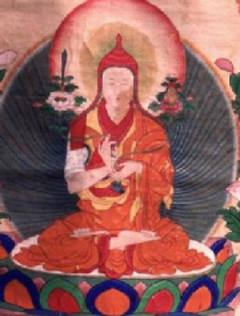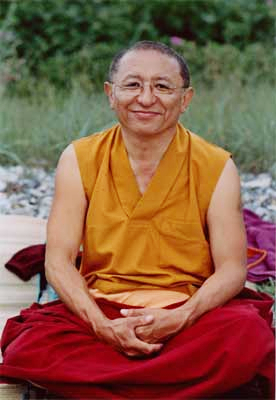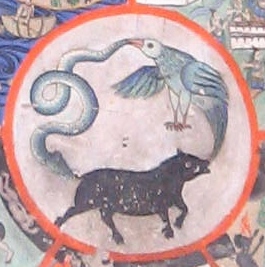Related Research Articles

Jamgön Kongtrül Lodrö Thayé, also known as Jamgön Kongtrül the Great, was a Tibetan Buddhist scholar, poet, artist, physician, tertön and polymath. He was one of the most prominent Tibetan Buddhists of the 19th century and he is credited as one of the founders of the Rimé movement (non-sectarian), compiling what is known as the "Five Great Treasuries". He achieved great renown as a scholar and writer, especially among the Nyingma and Kagyu lineages and composed over 90 volumes of Buddhist writing, including his magnum opus, The Treasury of Knowledge.
Tsele Natsok Rangdröl (1608-?) was an important master of the Kagyü and Nyingma schools of Tibetan Buddhism. He is also known as Tsele Gotsangpa.
Erik Pema Kunsang is a Danish translator and was, along with Marcia Binder Schmidt, director of Rangjung Yeshe Translations and Publications in Kathmandu. He has translated over fifty volumes of Tibetan texts and oral teachings. His other projects include the Rangjung Yeshe Wiki, an ongoing electronic publication that is compiling an extensive glossary of Buddhist terminology to bridge the Tibetan and English languages.
Amoha is a Buddhist term translated as "non-delusion" or "non-bewilderment". It is defined as being without delusion concerning what is true, due to discrimination; its function is to cause one to not engage in unwholesome actions. It is one of the mental factors within the Abhidharma teachings.
Dakpo Tashi Namgyal was a lineage holder of the Dagpo Kagyu lineage of Tibetan Buddhism. He was also trained in the Sakya lineage, and "was renowned as both a scholar and yogi."

Torma are figures made mostly of flour and butter used in tantric rituals or as offerings in Tibetan Buddhism. They may be dyed in different colors, often with white or red for the main body of the torma. They are made in specific shapes based on their purpose, usually conical in form. A very large, central shrine torma may be constructed for festivals, though typically they are small and placed directly on a shrine, on a plate, mounted on leather or held on a special base like a skull.
Jetsun or Jetsunma is a Tibetan title meaning "venerable" or "reverend." It is a specific term applied to revered teachers and practitioners of Vajrayana Buddhism. The title is applied to adepts and learned lamas such as Jetsun Milarepa. "Je" refers to those of high rank, including kings and nobles; "tsun" refers to 1) those of noble rank, 2) those who are monastics, or 3) those who combine the three characteristics of being learned, noble, and good. The two together emphasize the honorific while "tsun" applies the term specifically to ecclesiastics.
Māna is a Buddhist term that may be translated as "pride", "arrogance", or "conceit". It is defined as an inflated mind that makes whatever is suitable, such as wealth or learning, to be the foundation of pride. It creates the basis for disrespecting others and for the occurrence of suffering.

Chökyi Nyima Rinpoche is a Tibetan Buddhist teacher and meditation master. He is the abbot of Ka-Nying Shedrub Ling Monastery in Kathmandu, Nepal. He is the author of several books, founder of meditation centers around the world, and an international teacher.

The three poisons or the three unwholesome roots, in Buddhism, refer to the three root kleshas: Moha, Raga, and Dvesha. These three poisons are considered to be three afflictions or character flaws innate in a being, the root of Taṇhā (craving), and thus in part the cause of Dukkha and rebirths.
Īrṣyā is a Sanskrit or Buddhist term that is translated as "jealousy" or "envy". It is defined as a state of mind in which one is highly agitated to obtain wealth and honor for oneself, but unable to bear the excellence of others.
Adhimoksha is a Buddhist term that is translated as "interest", "intensified interest", or "decision". It is defined as holding onto a certain form object; its function is not to lose the object.
Advesha is a Buddhist term translated as "non-aggression" or "non-hatred". It is defined as the absence of an aggressive attitude towards someone or something that causes pain. It is one of the mental factors within the Abhidharma teachings.

Hri is a Buddhist term translated as "self-respect" or "conscientiousness". It is defined as the attitude of taking earnest care with regard to one's actions and refraining from non-virtuous actions. It is one of the virtuous mental factors within the Abhidharma teachings.
Apatrapya is a Buddhist term translated as "decorum" or "shame". It is defined as shunning unwholesome actions so as to not be reproached by others of good character. It is one of the virtuous mental factors within the Abhidharma teachings.
Alobha is a Buddhist term translated as "non-attachment" or "non-greed". It is defined as the absence of attachment or desire towards worldly things or worldly existence. It causes one to not engage in unwholesome actions. It is one of the virtuous mental factors within the Abhidharma teachings.
Prasrabhi is a Mahayana Buddhist term translated as "pliancy", "flexibility", or "alertness". It is defined as the ability to apply body and mind towards virtuous activity. Prasrabhi is identified as:
Śāṭhya is a Buddhist term translated as "hypocrisy", "dishonesty", "deception", or "concealment of shortcomings". It is identified as one of the twenty subsidiary unwholesome mental factors within the Mahayana Abhidharma teachings. In this context, it is defined as concealing one's own faults because of a desire for things such as honor and material gain.
Tsikey Chokling Rinpoche was a teacher, writer, religious ritual master, and meditation master of the Nyingma school of Tibetan Buddhism.

In Dzogchen, the view is one of the Three Dharmas of the Path of Dzogchen. The other two dharmas of the path are practice (gompa) and conduct (chöpa).
References
- ↑ "Rangjung Yeshe Wiki - Dharma Dictionary:Main Page". Rangjung Yeshe Wiki. Tsadra Foundation. Retrieved 24 November 2013.
- ↑ "Statistics - Rangjung Yeshe Wiki - Dharma Dictionary". Tsadra Foundation. Retrieved 2013-11-23.
- ↑ "Rangjung Yeshe Wiki - Dharma Dictionary". WikiApiary. Retrieved 2013-11-23.